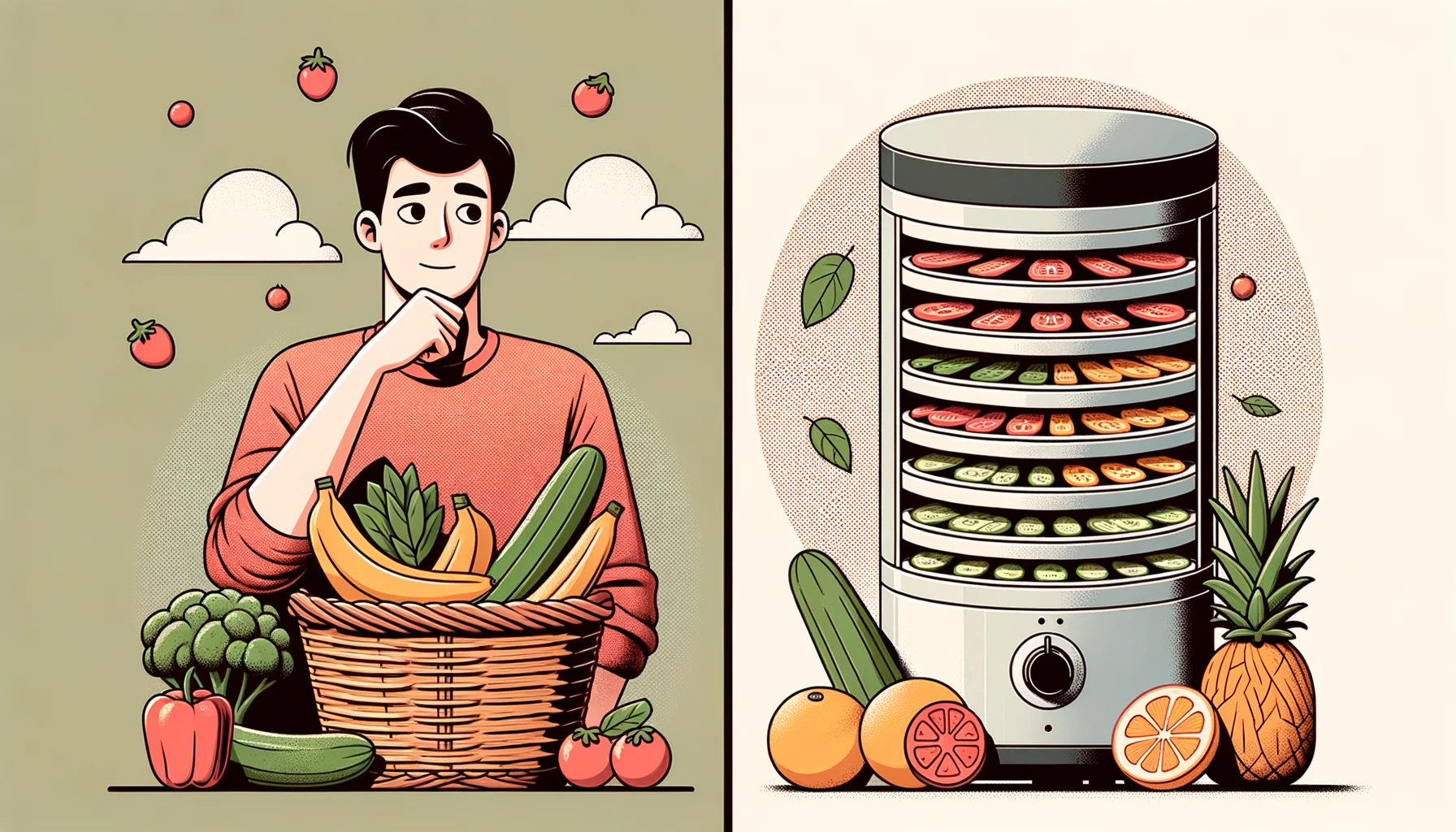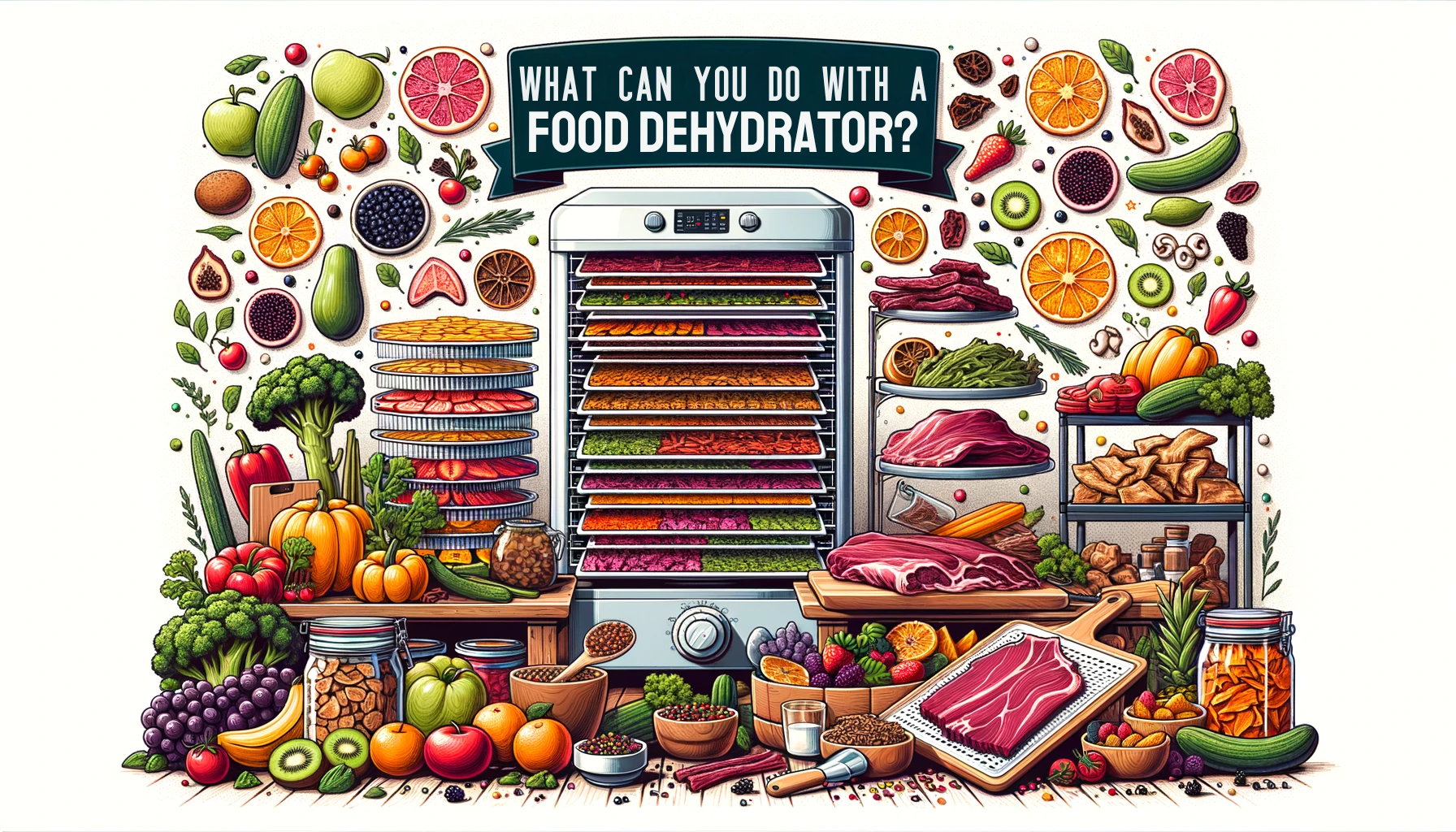Have you ever wondered if investing in a food dehydrator is really worth it? Whether you’re a health-conscious individual, a culinary enthusiast, or simply looking for a cost-effective way to preserve your favorite fruits and vegetables, this article will explore the many benefits and considerations of owning a food dehydrator. From maximizing nutritional value and reducing food waste to creating delicious and convenient snacks, a food dehydrator may just be the game-changing addition to your kitchen that you never knew you needed. Let’s take a closer look.
Benefits of Food Dehydrators
Preservation of Nutritional Value
Food dehydrators are a fantastic tool for preserving the nutritional value of your favorite fruits, vegetables, and meats. When foods are dehydrated, the moisture is removed, but the essential vitamins, minerals, and enzymes remain intact. This means that you can enjoy delicious, dried snacks without sacrificing the nutrients your body needs.
Convenience and Versatility
One of the greatest benefits of food dehydrators is the convenience they offer. With a dehydrator, you can easily transform fresh produce into tasty snacks that will last for months. You can also create your own trail mixes, jerky, and even dried herbs and spices. The versatility of food dehydrators allows you to be creative in the kitchen while reducing your reliance on store-bought processed snacks.
Reduction of Food Waste
Food waste is a significant issue in today’s society, and food dehydrators can play a crucial role in addressing this problem. With a dehydrator, you can salvage fruits, vegetables, and meats that may be nearing their expiration date. Instead of throwing them away, you can dehydrate them and extend their shelf life. This not only saves you money but also contributes to a more sustainable lifestyle.
Factors to Consider
Cost
When considering purchasing a food dehydrator, it’s important to factor in the cost. Dehydrators come in a range of prices, so it’s essential to determine your budget and find a model that fits within it. While some may be tempted to opt for the cheapest option, it’s important to strike a balance between affordability and quality to ensure you get a dehydrator that meets your needs.
Available Space
Another factor to consider is the available space in your kitchen. Food dehydrators come in various sizes, and it’s important to choose one that fits comfortably in your kitchen without taking up too much valuable countertop real estate. If space is limited, consider opting for a smaller, stackable tray dehydrator that can easily be stored when not in use.
Frequency of Use
Consider how often you plan on using your food dehydrator. If you anticipate using it frequently, investing in a high-quality model that can handle heavy use is worth considering. On the other hand, if you only plan on using it occasionally, a more budget-friendly option may suffice.
Quality and Type of Food
The quality and type of food you plan on dehydrating should also be taken into account. If you intend to dehydrate large quantities of fruits and vegetables regularly, a dehydrator with multiple trays and adjustable temperature settings may be ideal. However, if you primarily plan on dehydrating meat for jerky, a model specifically designed for that purpose may be more suitable.
Types of Food Dehydrators
Stackable Tray Dehydrators
Stackable tray dehydrators are a popular option due to their versatility and compact design. They typically consist of several stacking trays that can be used to dehydrate a variety of foods simultaneously. These dehydrators are great for those with limited space as they can easily be disassembled and stored when not in use.
Shelf Dehydrators
Shelf dehydrators are a larger and more robust option that offers higher capacity and more even drying. These dehydrators feature vertically aligned shelves that allow for better airflow and ensure consistent drying throughout the trays. Shelf dehydrators are perfect for those who plan on dehydrating larger quantities of food or who require more precise temperature control.
Box and Shelf Dehydrators
Box and shelf dehydrators combine the benefits of stackable tray dehydrators and shelf dehydrators. These dehydrators feature a box-like design with multiple shelves for increased capacity. The box design helps to trap and circulate heat, resulting in efficient and even drying. This type of dehydrator is ideal for those who require a larger capacity but still want the convenience of stackable trays.
Vertical Flow Dehydrators
Vertical flow dehydrators, also known as flow-through dehydrators, are designed to provide consistent airflow and drying throughout the trays. These dehydrators feature a vertical airflow design that prevents flavor transfer between different food items. With vertical flow dehydrators, you can dehydrate a variety of foods at the same time without worrying about cross-contamination.
Reviews and Rankings
Top 5 Food Dehydrators
- Excalibur 3926TB Food Dehydrator
The Excalibur 3926TB is a top-rated food dehydrator known for its large capacity and precise temperature control. With nine trays and adjustable thermostat settings, it offers plenty of space for dehydrating a variety of foods simultaneously. The built-in timer and convenient operation make it a favorite among culinary enthusiasts.
- Nesco FD-1018A Gardenmaster Food Dehydrator
The Nesco FD-1018A Gardenmaster is a highly versatile dehydrator with a powerful fan and airflow system for efficient drying. It comes with eight trays and expandable capacity, making it suitable for both small and large batches. The adjustable temperature and programmable timer add to its ease of use.
- COSORI Premium Food Dehydrator
The COSORI Premium Food Dehydrator is known for its modern design and user-friendly features. With six stainless steel trays and a digital control panel, it offers precise temperature and time settings for optimal drying. The included recipe book and mesh screens add to its overall value.
- Presto 06301 Dehydro Digital Electric Food Dehydrator
The Presto 06301 Dehydro Digital Electric Food Dehydrator is a budget-friendly option that doesn’t compromise on quality. It features a digital thermostat and timer for accurate drying and a see-through cover for easy monitoring. With six trays and expandable capacity, it offers sufficient space for various types of food.
- Tribest Sedona Express SDE-S6780-B Digital Food Dehydrator
The Tribest Sedona Express is a high-end food dehydrator with exceptional drying performance. It features a digital control panel, stainless steel trays, and dual fans for efficient and even drying. The spacious nine-tray capacity and versatility make it a popular choice among professional users.
Comparison of Features
The top-rated food dehydrators mentioned above vary in terms of capacity, temperature control, and additional features. However, they all provide efficient drying and reliable performance. When choosing a dehydrator, consider factors such as capacity, ease of use, and specific drying requirements to find the best fit for your needs.
Customer Reviews and Ratings
Customer reviews and ratings can provide valuable insights when choosing a food dehydrator. Take the time to read through both positive and negative reviews to get a comprehensive understanding of each dehydrator’s performance and potential drawbacks. Pay attention to reviews that highlight features that are important to you, such as ease of cleaning, noise level, and durability.
Health Concerns and Benefits
Preservation of Natural Enzymes and Probiotics
Food dehydrators allow you to preserve the natural enzymes and probiotics present in raw fruits, vegetables, and fermented foods. Enzymes play a crucial role in digestion and nutrient absorption, while probiotics promote a healthy gut microbiome. By dehydrating foods at low temperatures, you can retain these essential nutrients that would otherwise be lost during traditional high-heat cooking methods.
Reduced Sodium and Additive Consumption
Many store-bought snacks and processed foods contain high levels of sodium and artificial additives. By dehydrating your own snacks at home, you have complete control over the ingredients used. This allows you to reduce sodium content and eliminate artificial additives, creating healthier and more nutritious snacks for you and your family.
Controlled Snacking and Portion Sizes
Snacking can sometimes lead to overeating, especially with easily accessible pre-packaged snacks. By dehydrating your own snacks, you can control portion sizes and make healthier choices. Dehydrated fruits and vegetables are a great alternative to sugary or salty snacks and can be enjoyed in moderate portions without the guilt.
Tips for Using Food Dehydrators
Proper Food Preparation
Before dehydrating your foods, it’s important to properly prepare them. Wash and slice fruits and vegetables into uniform pieces to ensure even drying. Remove excess fat and marinate meats before dehydrating them for enhanced flavor. Proper food preparation not only ensures better results but also reduces the risk of foodborne illness.
Optimal Drying Time and Temperature
Each type of food requires specific drying time and temperature settings. It’s important to follow the manufacturer’s instructions and recommended drying times for different foods. Investing in a dehydrator with adjustable temperature settings allows you to tailor the drying process to different types of foods, ensuring optimal results.
Storage and Packaging Suggestions
Once your foods are dehydrated, proper storage is essential to maintain their freshness and quality. Store dried foods in airtight containers or vacuum-sealed bags to prevent moisture absorption and exposure to air. Keep them in a cool, dark place to extend their shelf life and minimize the risk of spoilage.
Comparison with Other Preservation Methods
Canning
Canning is a traditional method of preserving food that involves sealing foods in jars and heat processing them. While canning preserves foods through high heat, it can also lead to nutrient loss and changes in texture. Dehydrating foods, on the other hand, preserves nutrients while offering a different flavor and texture experience.
Freezing
Freezing is another common preservation method that involves storing foods at very low temperatures. While freezing can help retain nutrients, it can also result in changes in texture and flavor over time. Dehydrating foods not only preserves nutrients but also offers a great alternative for those with limited freezer space.
Air Drying
Air drying is a simple and low-cost method of preserving food by letting it dry naturally in the open air. While air drying can be effective for some foods, it often requires a significant amount of time and may not be suitable for all types of foods. Food dehydrators provide a more controlled and efficient drying process, ensuring consistent results.
Factors Affecting Dehydration
Air Temperature and Humidity
Air temperature and humidity levels can significantly impact the dehydration process. Lower humidity and higher temperatures will result in faster drying times, while higher humidity and lower temperatures will prolong the drying process. It’s important to monitor these factors and adjust the drying time and temperature accordingly for optimal results.
Food Thickness and Water Content
The thickness and water content of the food being dehydrated also play a role in the drying process. Thicker slices will take longer to dehydrate, while foods with higher water content will require more drying time. It’s important to consider these factors and make adjustments accordingly to ensure all food items are evenly dehydrated.
Cost Comparison Analysis
Initial Investment
The initial investment for a food dehydrator can vary depending on the brand, size, and features. Stackable tray dehydrators tend to be more affordable, with prices ranging from $40 to $150. Shelf dehydrators and box and shelf dehydrators typically range from $150 to $300. Higher-end dehydrators with advanced features can cost anywhere from $300 to $600.
Operational Costs
Food dehydrators are generally cost-effective to operate. They consume minimal electricity compared to other kitchen appliances and have low maintenance requirements. The cost of electricity depends on the model and usage, but it is generally quite affordable. Additionally, using a food dehydrator allows you to save money on store-bought snacks and reduce food waste, leading to long-term cost savings.
Comparison with Store-Bought Dehydrated Foods
Store-bought dehydrated foods may seem convenient, but they often come at a significant markup and may contain additives and preservatives. By investing in a food dehydrator, you have full control over the quality of the ingredients used and can customize the flavors to suit your preferences. In the long run, dehydrating your own foods can be much more cost-effective and beneficial for your health.
Environmental Impact
Reduced Packaging Waste
Using a food dehydrator allows you to significantly reduce your reliance on store-bought snacks that often come in single-use plastic packaging. By dehydrating your own foods, you can store them in reusable containers, reducing the amount of plastic waste generated. This small change can have a positive impact on the environment and contribute to a more sustainable lifestyle.
Energy Consumption
While food dehydrators do consume electricity, they are generally energy-efficient appliances. Compared to more common appliances like refrigerators or stoves, food dehydrators require significantly less energy to operate. By using energy-efficient models and optimizing drying times, you can further minimize the environmental impact of your food dehydrator.
Sustainable Food Preservation
Food dehydrators offer a sustainable method of food preservation that helps combat food waste. By dehydrating foods that may otherwise go bad and end up in the trash, you are not only saving money but also reducing your carbon footprint. The ability to capture the nutritional value of fruits, vegetables, and meats without resorting to traditional preservation methods is a step towards a more sustainable future.
In conclusion, food dehydrators provide numerous benefits, including the preservation of nutritional value, convenience and versatility, and the reduction of food waste. Before purchasing a food dehydrator, it’s important to consider factors such as cost, available space, frequency of use, and the quality and type of food you plan on dehydrating. There are different types of dehydrators available, each with its own advantages and considerations. Reviews and rankings can help guide your decision-making process, and understanding the health concerns and benefits of using food dehydrators can further inform your choices. Tips for using food dehydrators, a comparison with other preservation methods, and a cost comparison analysis all contribute to a well-rounded understanding of food dehydrators. Lastly, considering the environmental impact of food dehydrators highlights their sustainability and positive contribution to reducing waste. With all this information, you can decide if investing in a food dehydrator is worth it for you and enjoy the benefits of preserving your favorite foods in a nutritious and environmentally friendly way.



